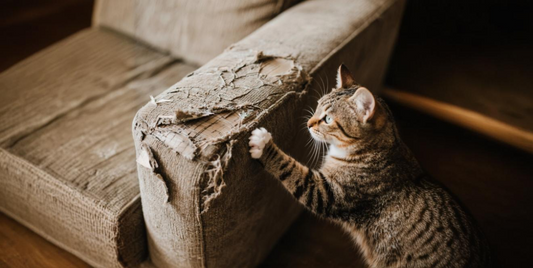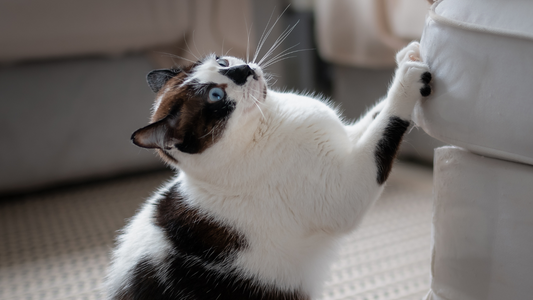Scratching Is Instinct, Not Misbehavior
Cats don’t scratch furniture or cardboard boxes because they’re being naughty — it’s hardwired into their DNA. Scratching is a natural feline behavior that serves several key functions:
- Territory marking: Cats have scent glands in their paws, and scratching leaves both a visual and scent-based marker.
- Claw maintenance: It helps remove the dead outer layer of their claws.
- Stretch and stress relief: Scratching offers a satisfying full-body stretch and emotional outlet.
Understanding these core reasons can help cat parents see scratching not as damage control, but as an essential wellness behavior.
The Science of Scratching: What’s Going on Biologically?
Scratching isn't just about surface destruction — it’s a multisensory experience. When cats scratch:
- Tendons and muscles engage: It’s like feline yoga.
- Pheromones are released: These chemical messages communicate with other cats.
- Neurological benefits: Scratching can trigger dopamine responses that relieve anxiety and boost mood.
This is why scratching is often more pronounced in multi-cat households or when a cat is adjusting to a new environment.
The 3 Common Scratching Styles
Each cat has a preferred way to scratch — and it often reveals something about their personality and comfort level. If you’re deciding which scratcher type to buy, our hands-on buying advice is in Choosing the Right Cat Scratcher — Flat, Vertical, or Lounge Style?
- Vertical Scratchers: Wall posts, furniture arms, or door frames. Often preferred by confident, dominant cats who want their scent and marks front and center. For an upright option that satisfies tall stretches, try the Hide & Scratch Vertical Cat Scratcher Box.
- Horizontal Scratchers: Flat surfaces like rugs, cardboard pads, or boxes. Favored by relaxed or low-energy cats who enjoy lounging before or after scratching. The spacious Hide & Scratch Extra Large Cat Scratcher Box is perfect for cats who love a broad, flat surface.
- Angled or Incline Scratchers: Appeal to cats who like a mix of stretch and clawing action, mimicking movement on tree trunks in the wild.
Some cats use more than one style depending on their mood, age, or daily activity level.
Scratching Styles Through the Life Stages
- Kittens: Scratch impulsively and experimentally; introducing varied textures early builds healthy habits.
- Adult cats: Settle into consistent patterns and often return to the same spot for both marking and stress relief.
- Senior cats: May adapt habits due to joint stiffness, shifting toward lower, more accessible surfaces.
Being mindful of these shifts helps you choose the right scratcher design and location to support feline wellness throughout their life.
Environment Matters: Indoor vs. Outdoor Influences
Whether your cat is an indoor snuggler or an outdoor adventurer can impact their scratching style:
- Outdoor cats: Often scratch trees, fence posts, or other rough vertical surfaces. Indoors, they may seek similar tall structures.
- Indoor cats: May be more selective; placement, texture, and variety become especially important. Cardboard, sisal, and carpet can mimic natural textures when thoughtfully chosen.
Offering a range of scratcher types indoors helps compensate for what they’d naturally seek outside.
Observing Your Cat’s Preferences
Pay attention to when and where your cat scratches. Notice:
- Scratching time: After waking, during play, or when stressed?
- Preferred textures: Cardboard, sisal rope, or soft carpeting?
- Location tendencies: Near their bed, by a window, or next to furniture?
These cues guide you toward the most appealing type of scratcher and the best placement. If you’re trying to move scratching away from furniture, practical step-by-step redirection lives in How to Stop Furniture Scratching — By Matching Your Cat’s Scratching Style.
Conclusion: Support Healthy Cat Scratching Behavior with the Right Scratchers
Scratching is essential for your cat’s health, happiness, and communication. Understanding the “why” behind the behavior helps you match the “what” — the right scratchers for their unique needs. From vertical and horizontal options to incline designs and varied textures, thoughtful choice and placement will support natural instincts and protect your home. For product-specific guidance, don’t miss Choosing the Right Cat Scratcher, and for behavior change tactics, see How to Stop Furniture Scratching.





